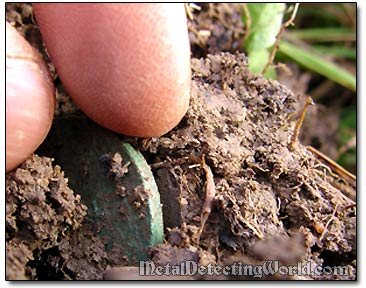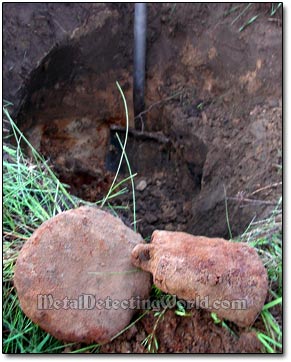My Search Programs for Minelab E-Trac and CTX 3030 Metal Detectors
SEARCH PROGRAM #2 For Detecting Coins and Non-Ferrous Artifacts in Farm Fields, p.1
Because both the E-Trac's FBS (Full Band Spectrum) and CTX 3030's FBS2 technologies are designed to detect on any ground without a trouble, metal detecting old coins and non-ferrous relics in the plowed or abandoned fields is even easier than at the homestead sites due to the uniform distribution of natural and sporadic mineralization in soil. And, without implementation of any "aggressive" program settings, the Minelab advanced technologies allow to detect targets in areas where treasure hunters with detectors of other brands quit searching long time ago.
Treasures Might Be Hidden in Any Field

There are two main objectives of "field scanning": 1) locating sites of former settlements, and 2) locating so called "coin scatters" - "constellations" of identical coins interspersed in soil and on the surface after they had been dislodged from the buried coin caches (hoards) and brought up to the ground surface by plowing and soil frosts over many years. The coin scatters indicate the coin hoards still buried underneath, and can be located both within and outside the former dwelling sites.
Of course, the "field scanning" can be also done just to find single coins and/or non-ferrous artifacts that were individually lost a long time ago. In any case, this metal detecting program can effectively help you meet your objectives. It works in areas that do not have high accumulation of junk and might contain buried coin hoards and/or artifact caches. Such areas may include the outskirts of the former settlement sites.
This is why the large-sized search coils are preferred for this type of treasure hunting - FIELD DETECTING. If you wish to metal detect directly at the former settlement site that you have discovered, you should use any level program settings of my 3-Level 'COINS' search program and smaller search coils, depending on a level of trash.
NOTE 1: In the "Level 1 - High Discrimination/Low Noise" Program Description, I explained every program setting's level or mode I utilize. If any setting in the following program has a different mode or level, or not utilized at all, a clarification will be given accordingly. Otherwise, please refer to the Level-1 Program Description for detailed explanations of program settings and useful tips for their implementation.
NOTE 2: While all the E-Trac functions, program setting and modes are given in black, the program settings of the Minelab CTX 3030, references to their description pages in the CTX-3030's Instruction Manual, and my short notes on their utilization in this program are given in this pink font color.
NOTE 3: I ALWAYS operate my metal detectors with headphones.
NOTE 4: As soon as you encounter a spot with iron nails indicated by either frequent nulling of Threshold or the lowest tone pitch, utilize the 3-Level search program for detecting coins at the site of former settlement, replace the search coil with a smaller one, and start sweeping a search coil extremely SLOW. Slow coil swinging allows to detect good targets lying beside iron nails, and hear the low-tone responses from accepted iron targets without additional high-pitched falsing.
SEARCH COILS:
Both a standard (stock) 11" DD search coil (for CTX-3030: 11" DD Smart Coil) and search coils of larger sizes (for E-Trac: 12x10" SEF (Butterfly), 13" Ultimate DD, 15x12" SEF (Butterfly), 18x15" SEF (Butterfly), etc.; for CTX 3030: CTX 17 Smart Coil) should be used for detecting the deep-buried and masked coins and other non-ferrous targets with program.
PROGRAM SETTINGS for NEUTRAL or LOW-MINERALIZED GROUND:
NOTE 5: Some program settings for detecting on HIGH-MINERALIZED grounds are included and explained.
NOTE 6: Summary Tables for these program settings are shown at the bottom of next page.
DETECTION SCREEN - PATTERN Screen (to select this mode, press "Detect" button; page 23 of the E-Trac Instruction Manual) - see details on page 2 of my 3-Level Search Program description.
CTX 3030:
DETECT Screen (page 7 of the CTX-3030 Instruction Manual)
Sensitivity Menu:
(see details on page 3 of my 3-Level Search Program description)
SENSITIVITY - Manual at 25 (page 56 of the E-Trac Instruction Manual)
CTX 3030:
SENSITIVITY - Manual at 25 (page 21 of the CTX-3030 Instruction Manual)
Setting the Manual Sensitivity level higher may bring negative results as a large search coil will scan a few gallons of dirt and a lot of mineral content contained in it. If mineralization intensity is above a moderate level, your metal detector will respond to the ground with many false signals, and the detector depth penetration will be greatly reduced.
The Manual Sensitivity should be set on the detector's stability level. If mineralization is too high, select the 'AUTO' mode of Sensitivity to avoid both ground and iron falsing.
AUTO SENSITIVITY LEVEL - A if you use AUTO SENSITIVITY (page 55 of the E-Trac Instruction Manual)
CTX 3030:
AUTO SENSITIVITY LEVEL - A if you use AUTO SENSITIVITY (page 21 of the CTX-3030 Instruction Manual)
Audio Menu
(see details on page 4 of my 3-Level Search Program description)

THRESHOLD LEVEL - 15 (page 58 of the E-Trac Instruction Manual)
CTX 3030:
THRESHOLD LEVEL - 15 (page 23 of the CTX-3030 Instruction Manual)
VOLUME LIMIT - 15 (page 60 of the E-Trac Instruction Manual)
I do not recommend setting the VOLUME LIMIT at higher levels unless you do not use headphones, or your headphones have in-built volume controls which ARE USED for volume adjustment. A high VOLUME LIMIT setting might damage your hearing when an oversized target is detected.
If you use wireless headphones with your E-Trac, set the VOLUME LIMIT to 15. This improves the quality of wireless sound transmission (my article on "How To Make E-Trac Wireless" will be posted soon and announced in the "New Additions" (Visitor's Corner) section of this web site).
CTX 3030:
VOLUME LIMIT - 15 (page 24 of the CTX-3030 Instruction Manual)
VOLUME GAIN - 28 (page 61 of the E-Trac Instruction Manual)
CTX 3030:
VOLUME GAIN - 28 (page 23 of the CTX-3030 Instruction Manual)
RESPONSE - Long (page 62 of the E-Trac Instruction Manual)
I am just used to this mode. Try 'NORMAL' or 'SMOOTH' and see whichever you like better.
CTX 3030:
RESPONSE - Long (page 39 of the CTX-3030 Instruction Manual)
NUMBER OF TONES - 4 Tones (use the Tone ID sub-menu; page 64 of the E-Trac Instruction Manual)
The NUMBER OF TONES setting is not available in CTX-3030
Along with the FERROUS Sounds employed, the current Discrimination pattern (shown on page 3) changes the E-Trac's "4 TONE FERROUS" audio setup into 3-Tone Ferrous. Under current metal detecting conditions in the farm field, you may encounter a very little amount of superficial non-ferrous targets such as pull tabs, clad coins, aluminum wire, brass casings, etc., so every high-tone response you now get will be worth investigating.
CTX-3030:
TONE PROFILE TYPE - 4 Tone FE (page 36 of the CTX-3030 Instruction Manual)
This Tone ID Profile is used with the E-Trac's Discrimination pattern shown on page 3, but does NOT become "3 Tone FE" as the E-Trac's audio setup because the CTX 3030's tone bins can be resized (see details on page 10 of my tutorial - "How To Use Minelab XChange 2 for EDITING") to keep all four tones.

Under current metal detecting conditions in the farm field, you may encounter a very little amount of superficial non-ferrous targets such as pull tabs, clad coins, aluminum wire, brass casings, etc., so every high-tone response you get will be worth investigating. If you do that, you may get lucky and unearth a small iron relic cache like the one shown on a picture to the right.
SOUNDS - Ferrous (page 65 of the E-Trac Instruction Manual)
The SOUNDS setting is not available in CTX-3030
CTX-3030:
TONE PROFILE TYPE - 4 Tone FE
This setting performs the combined function of two E-Trac's modes - NUMBER OF TONES and FERROUS SOUNDS.
VARIABILITY - n/a (page 67 of the E-Trac Instruction Manual)
This setting does not really play a big role unless you utilize the MULTI SOUNDS mode
VARIABILITY setting is not available in CTX-3030
TONE ID LIMITS - n/a (page 68 of the E-Trac Instruction Manual)
This setting is only available when the NUMBER OF TONES is set to MULTI.
The TONE ID LIMITS setting is not available in CTX-3030
TRESHOLD PITCH - 17 (page 69 of the E-Trac Instruction Manual)
CTX 3030:
TRESHOLD PITCH - 17 (page 24 of the CTX-3030 Instruction Manual)